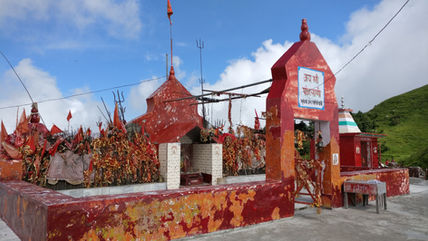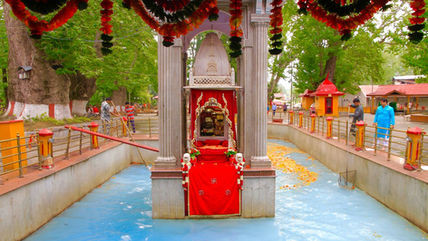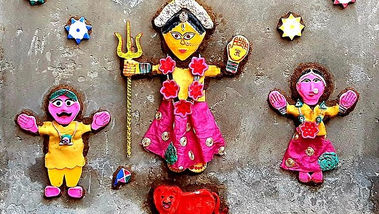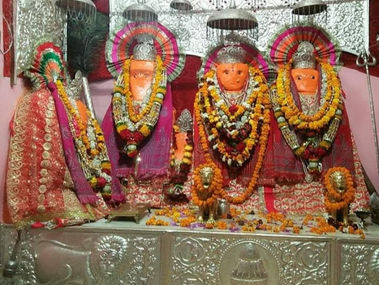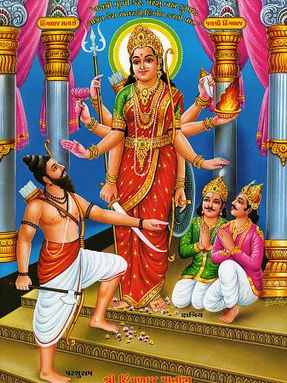
Regional
Goddesses
Village and regional deities are the most ancient aspect of Indian religion. These deities are either associated with the mainstream Hindu tradition or have their independent cult and origin. Some of them are considered to be originated from the pre-Vedic beliefs of indigenous inhabitants but many are of quite a recent origin. People who died violently, or who have been notorious for their power or their sacrifices, are often worshipped after their death, as a deity. Most of these deities are grama devata (village deities) who protect their devotee or the people of their province from diseases and disasters. Each village or region is considered to be under the protection of a guardian deity or grama devata. The addition of new deities is prevalent even now, and hence there are countless deities across India and most of them are exclusively female. Hinduism also has many Kuldevtas, tutelary deities. They are worshipped by particular clans, castes, and sometimes families. Kuldevtas are different from grama devata and other regional deities, but sometimes their origin and temples are correlated with regions. Several regional deities also are adopted as tutelary deities by people of that domain.
The regional goddesses are represented as aniconic, either as a shapeless stone, mountains, snake-hole, or any other natural formations. With time, many regional goddesses and practices got influenced by Brahminical practices. The story surrounding these deities varies considerably by region, but most of these deities are now rooted in the idea of Shakti as the primordial goddess. These goddesses are worshipped as a form of Goddesses like Durga and Kali, apart from historical heroines. Most of the time, their iconography is comparable in a particular region. Another interesting viewpoint is that several goddesses are named after the village or city they reside in or vice versa. Notable examples are Shakti pithas and various regional forms of major Hindu goddesses.
It is challenging to identify many regional deities in India due to a lack of research and documentation. The following list includes some prominent local Hindu deities from various Indian states and nearby nations.
Northern India
In the northern part of India, the rich tapestry of Hindu mythology and traditions come alive through the worship of various regional goddesses, each exuding her unique divine grace and significance.
Chandigarh
Chandigarh means “the fortress of Chandi”. The name of the city is derived from an ancient Chandi temple near Panchkula District, in Haryana. Devotees in the area worship goddesses such as Basanti Mata, whose shrines are dispersed throughout Chandigarh and surrounding states, and Kansa Devi, whose temple is located close to Kansal village.
Delhi
Jhandewalan is a prominent goddess in Delhi, also called “Maa Jhande Wali” since a huge flag (Jhanda) was installed by Badri Das for her prayer. The legend narrates how a merchant named Badri Das discovered a buried idol at the temple site and installed a grand flag (Jhanda) in her honor. The goddess is portrayed seated on a lion and she has four hands carrying a sword, bowl, trident, and conch.
Himachal Pradesh
Numerous deities are venerated in the state of Himachal Pradesh. One of the 51 Shakti Peethas, Jwala Ji is worshipped in the temple in Jawalamukhi, Kangra district. Her name comes from the frequent flames that come from the shrine as a result of natural gas usage.
The presiding deity of the ruling elite of the ancient princely state of Bushahr, Bhimakali, makes her domicile in the Sarahan temple. The goddess Hadimba Devi, who wed Bhima from the Mahabharata epic, has a temple near the town of Manali. Another renowned Shakti Peetha in Kangra is the Vajreshwari Mata shrine, which honors a particular manifestation of Mahishasuramardini. She's shown with four arms, holding a trident, sword, and bell, and her left-hand holding the tail of the Mahishasura. Simsa Mata is worshipped in Simas, Maa Bhangayni in Haripurdhar, and Bhalei Mata is worshipped in Bhalei. Pohlani Mata's temple is in Rakhed, whereas Nerasa Devi's shrine is at Naras village in the Bilaspur district. Other goddesses are Chintpurni, Haridevi, Baniya, Jhunga, and Dharech, whose shrines are situated in the respective towns of Chintpurni, Bilaspur, Solan, Bhadrol Uparla, and Dharech.
Haryana
Haryana is also the home of a few local goddesses, who are revered with individual shrines spread around the state. Though not being widely recognized in pan-Hindu traditions, these goddesses have a distinct position in local worship. The Chhitane Wali Mata temple is located in Bada Bazzar's Sunaron Street, while the Bhimeshwari Devi shrine is located in Beri Dopana. The Sawal Devi temple in Sewah serves as a place of worship, and at Bhanbhori, devotees congregate at the Bhanbhori Devi temple. The Bhoja Wali Devi and Phoolm Devi temples are located in Bhiwani and Dhanana, respectively.
Jammu and Kashmir
In Jammu and Kashmir, a region rich in spirituality, several different deities are honored. A prominent Shakti Peetha in Neelum Valley is where Shradha Devi, a deity connected to learning, was residing before the destruction of the temple. The sacred temple of Kheer Bhawani in Tulmul is built above a natural spring, and Sartal Devi's shrine is in Kishtwar.
While Vaishno Devi, a manifestation of Kali, Lakshmi, and Saraswati, attracts millions of pilgrims to her shrine in Katra at the Trikuta Mountain. In the Varaha Purana, she is known as Trikala, the goddess born of Trimurti. She defeated Mahisasura on Satasranga Parvata, which is now the home of Vaishno Devi. In the Devi Mahabhagavata Puranam, she is referred to as Vishnupriya, indicating that she is the one who is beloved by Vishnu.
Machail Mata is revered in the Machail village of the Kishtwar District. In Srinagar, Zeashta Devi and Mata Sharika Devi are revered. Mata Sharika Devi, is also the goddess who serves as the tutelary deity of the Baj Basanta dynasty.
Punjab
In Punjab, devotees seek Lal Devi's blessings at her temple in Amritsar. Lal Devi was born in the Kasoor locality of Pakistan's Lahore district in 1923. She arrived to Amritsar after India's partition and attained Nirvana in 1994. The Lal Devi temple is made in a man-made cave style decorated with beautiful artwork and brilliant colors. Julfa Mata's temple is a revered place of worship in Nangal. Although her temple is not commonly counted among Shakti Peethas, it is claimed that Sati's hair fell here. Jayanti Devi, the regional goddess, has her shrine on the Jayanti Majri village hilltop. Goddess Sanjhi is a folk goddess worshipped in Punjab during Navaratri.
Uttarakhand
Uttarakhand is renowned for its religious traditions, and is home to dedicated goddesses such as Naina Devi in Nainital, Surkanda Devi in the Saklana Range, and Chandrabadani Devi on the Chandrabadani peak. Dhari Devi's temple on the Alaknanda River in Garhwal, Hariyali Devi's temple in Rudraprayag, Jawalpa Devi in Jawalpa, and Garjiya Devi's temple near Ramnagar and Kasar Devi in Kasar Devi village are further places of devotion. Mathiyana Devi Temple is located in Mathiyana Khal village. In a certain account, her stepmother murdered her husband with the help of a few relatives. When her husband was burned, she obtained sati and transformed into a divine spirit, vowing vengeance on all murderers.
Garh Devi is another goddess worshipped in Uttarakhand, she is the consort of Golu Devata, a deity of the Kumaon region, and Kotgari Devi, a goddess of Justice, has her abode located in Kumaon hills. Nanda Devi is the goddess of Nanda Devi Mountain and a patron deity of the region. The mountain has two peaks in its range; the western one is higher and is called Nanda and the lower eastern peak is called Sunanda, her sister. Both goddesses are worshipped together in various parts of the state. Nanda Devi is a rare example of a mountain being personified as a goddess.
Uttar Pradesh
Vishalakshi Mata's temple in Varanasi is a renowned Shakti Peetha in the culturally diverse state of Uttar Pradesh. The Alopi Devi temple in Allahabad is related to the moving narrative of a bride who mysteriously vanished during a robbery. Devotees continue to be inspired by Bhandari Devi's historic temple in Bindpur Khurd, Nayar Devi's temple in Heeraganj, and Belha Devi's temple in Bela Pratapgarh. Parhul Devi's temple is in the Kanpur Dehat district, Vandevi's temple is around 6 kilometers from Renukut, Hulka Devi's temple is in Moradabad, and the temple of Sankahtha Mata is in Varanasi. The Temple of Shakambhari is located in Saharanpur and is an important pilgrimage. In this temple, the Shakambhari goddess is shown with Shatakshi Devi on her left, and Bheema Devi and Brahmari Devi on her right.
There are nine forms of Gauri, called Nav Gauri, which resides in Varanasi. They are Mukhnirmalika Gauri, Jyeshta Gauri, Saubhagya Gauri, Shringar Gauri, Vishalakshi Gauri, Lalita Gauri, Bhavani Gauri, Mangla Gauri, and Mahalaxmi Gauri. Their temples are situated at different locations across Varanasi and these goddesses are collectively worshipped during Navaratri.
Pakistan
In Pakistan, where Hinduism has a long history, very few Hindu temples have survived. Hinglaj Mata's shrine is a well-known Hindu pilgrimage site. Local Muslims refer to the temple as "Nani Mandir" or "Nani Ki Haj," which translates as "maternal grandmother's temple." It is one of the 51 Shakti Peethas and is located in the Lasbela District. The Charan clan worships her as their Kuldevi. According to tradition, she saved the tribe from annihilation by Lord Parashurama.
Shivaharkaray is another Shakti Peeth devoted to the Hindu Mahishasuramardini, The ancient is located near the Parkai railway station in Karachi, Pakistan.
Nepal
Nepal is a country with a complex tapestry of religious traditions, and there are several local deities that hold authority there. Each of these respected gods has a unique presence and significance, and they are worshipped all around the nation.
The Badimalika Temple, regarded as a Shakti Peetha, is located in Sudurpashchim Pradesh's Bajura district. Bageshwari's Temple is in Bhaktapur District, whereas Bhutandevi, who is a form of the goddess Durga with 18 arms, rules the Makwanpur district. Muktinath Temple in Mustang District, which is known as another Shakti Peetha, is where Gandaki Chandi resides. Kankalini, another form of Durga, is honored in Saptari in the Kankalini Temple which is also a Shakti Peetha.
Guhyeshwari Temple, a Shakti Peetha that is located in Kathmandu, gets its name from being the "goddess of the cave." On the peaks of Taplejung, the hill deity Pathibhara Devi is worshipped. Saptari District is home to the Dakneshwari Temple, whereas Sunsari District is graced by the Dantakali Temple. On the Palanchowk hill located in Kavrepalanchok, Palanchowk Bhagwati, an eighteen-armed goddess Durga, resides. Shobha Bhagawati Temple is in Pokhara, Balkumari Devi Temple is in Bhaktapur District, and Manakamana Devi Temple is in the village of Manakamana in the Gorkha District.
Svasthani is a local Nepali goddess who represents the diversity and hybridity of traditional female and divine characteristics. She is depicted seated upon Astha Matrikas or a lion. She has four hands, carrying a sword, lotus, and shield, and two lower hands in Abhaya and Varada mudra.
Taleju Bhawani's temple is located in Kathmandu Valley. She is the royal goddess of the Malla dynasty. She is depicted with four heads and eight arms on Golden Gate at the Bhaktapur Durbar Square.
As manifestations of Devi, Kumaris are respected in Nepalese society and take part in religious and cultural activities. Young prepubescent females known as Kumaris are carefully selected members of the prestigious Shakya caste within the thriving and culturally diverse Nepalese Newari society. These selected ladies are respected and honored as living representations of the goddess Devi because they are said to possess celestial traits. Their encounters with the public are meaningful and frequently characterized by blessings being given.
Siddhi Laxmi is a tantric goddess, considered a full manifestation of Shakti or Yogmaya. She is portrayed with five heads which depict satwa, rajas, tamas, trigunatita, and agyata guna. Her ten hands, carry a sword, vajra kilaka, bell, skull cup, noose, trident, a severed head, and, the remaining three hands in Abhaya, Varada, and Prithvi mudra. She is adorned with a garland of skulls. Aakash Bhairava supports her with his hands.
Bhavani is a goddess from nineteenth-century Nepalese art. She is shown emerging from the sudden blast of the enormous fire, which symbolizes both the end and beginning of time and space. She has sixteen crowned heads, and they are arranged in a pyramid. Her faces are rendered in several different primary colors, and each face has a third eye. She is standing on Mahakala, a wrathful form of Shiva, who is lying on a lotus coming out from Shiva.



